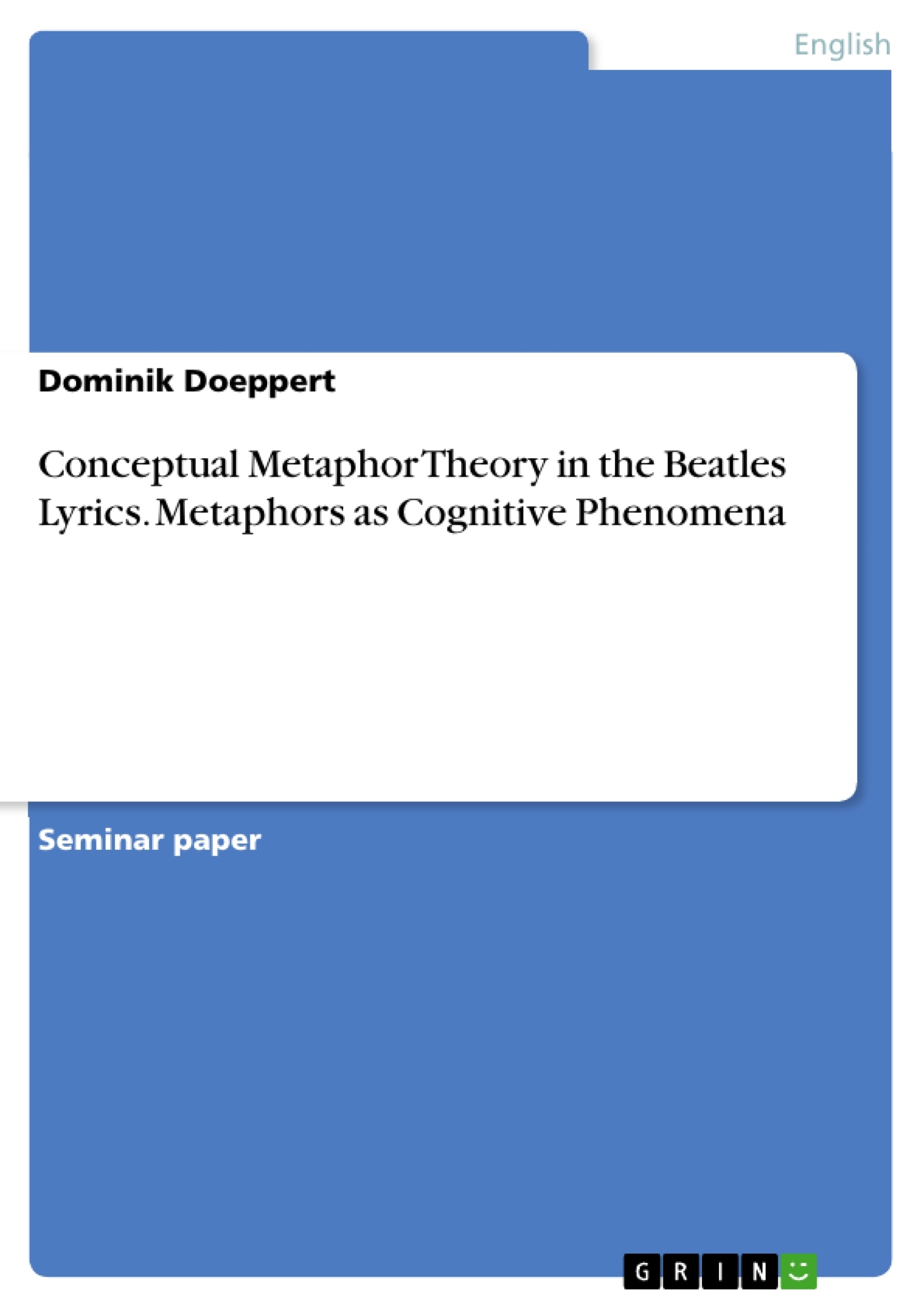Most people consider metaphors to be merely linguistic devises that are used for poetic purposes. A standard dictionary definition of metaphor is quite similar. The Oxford Dictionary defines metaphor as “a word or phrase used to describe sb/sth else[…]”.
This definition falls in line with a layman’s notion of metaphors being purely linguistic with the sole purpose of functioning as decorative features. However, metaphors go much deeper than that. Metaphors are in fact fundamental components of human cognition that are not just linguistic but conceptual in nature. Through metaphors, patterns of thought in a society are encoded and shared.
So in order to show that metaphors share patterns of thought in a society, songs of the Beatles shall be examined, seeing as the Beatles are one the most popular and successful bands of our time with fans from all around the world. The metaphors used in the Beatles’ songs are not merely figures of speech or stylistic devises, but cognitive phenomena that share patterns of thought in a society. The Beatles songs are a great medium to help prove that conceptual systems play a paramount role in establishing our everyday realities because of they are so widely popular. This paper seeks to show that Lakoff’s and Johnson’s notion of metaphors representing a way of thinking, as made popular in their Conceptual Metaphor Theory, also holds true for metaphors in the Beatles’ songs.
Drawing upon Lakoff’s and Johnson’s Conceptual Metaphor Theory, this paper also attempts to illuminate how the Beatles success is, at least partly, due to the systematicity of metaphorical concepts. Even though most people are not normally aware of conceptual systems present in our society, most of these conceptual systems are indeed metaphorical in nature and determine to a large extent our perception of the world. The metaphorical concepts present in the Beatles lyrics are very much coherent with the metaphorical structuring of certain experiences in our society, which is why so many people can relate to the Beatles’ songs because the concepts expressed therein are compatible with their conceptualisation of how they perceive the world.
Inhaltsverzeichnis (Table of Contents)
- Introduction
- Approaches to Metaphor
- Conceptual Metaphor Theory
- Metaphors as Cognitive Phenomena
- The Systematicity of Metaphorical Concepts
- Highlighting and Hiding
- Non-Cognitive Approaches
- Conceptual Metaphor Theory
- Orientational and Ontological Metaphors
- Orientational Metaphors
- Ontological Metaphors
- Entity Metaphors
- Container
- Personification
- Analysing Conceptual Metaphors in the Beatles' Lyrics
- Metaphors and Time
- Metaphors and Communication
- Metaphors and Emotions
- Metaphors in the Beatles' Lyrics and Their Cultural Coherence
- Values Deeply Embedded in Our Culture
- Embedding as Part of the Beatles' Widespread Success
Zielsetzung und Themenschwerpunkte (Objectives and Key Themes)
This paper aims to demonstrate that metaphors, contrary to popular belief, are not merely linguistic devices used for poetic purposes, but rather fundamental components of human cognition, conceptual in nature, and essential for encoding and sharing patterns of thought within a society. It will do so by examining the Beatles' lyrics, a popular and globally influential music source, and analyzing the metaphorical concepts embedded within them. The paper will explore how these metaphors reflect and reinforce cultural values and contribute to the Beatles' widespread success.
- Metaphors as cognitive phenomena: The paper will explore the concept of metaphors as cognitive tools that shape our understanding of the world.
- Systematicity of metaphorical concepts: The paper will investigate how metaphorical concepts are structured and interconnected within a society's shared cognitive system.
- Cultural coherence of metaphors: The paper will analyze how the metaphors in the Beatles' lyrics reflect and reinforce values and patterns of thought prevalent in Western culture.
- Metaphors in music and popular culture: The paper will explore the role of metaphors in music and their contribution to the success and impact of popular artists.
- Conceptual Metaphor Theory: The paper will apply Lakoff and Johnson's Conceptual Metaphor Theory to analyze the metaphorical concepts present in the Beatles' lyrics.
Zusammenfassung der Kapitel (Chapter Summaries)
The introductory chapter establishes the paper's central argument that metaphors are not just linguistic devices but cognitive phenomena that reveal patterns of thought in a society. This is further explored by examining the Beatles' lyrics, a culturally significant body of work that reflects shared conceptual systems.
Chapter 2 delves into different approaches to metaphor, focusing on Lakoff and Johnson's Conceptual Metaphor Theory. This theory posits that metaphors are not merely linguistic but cognitive, shaping our understanding of abstract concepts by mapping them onto concrete experiences.
Chapter 3 examines the role of orientational and ontological metaphors in shaping our perception of the world. Orientational metaphors relate to spatial concepts, while ontological metaphors involve mapping abstract concepts onto physical entities.
Chapter 4 analyzes specific instances of conceptual metaphors in the Beatles' lyrics, focusing on themes such as time, communication, and emotions.
Chapter 5 explores the cultural coherence of the metaphors found in the Beatles' lyrics, demonstrating how they reflect and reinforce values deeply embedded in Western culture. The chapter also investigates how this cultural resonance contributes to the band's widespread success.
Schlüsselwörter (Keywords)
This paper focuses on conceptual metaphor theory, cognitive linguistics, music analysis, popular culture, the Beatles, cultural values, metaphorical concepts, and the systematicity of thought.
- Quote paper
- Dominik Doeppert (Author), 2015, Conceptual Metaphor Theory in the Beatles Lyrics. Metaphors as Cognitive Phenomena, Munich, GRIN Verlag, https://www.grin.com/document/304592



